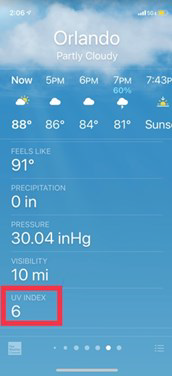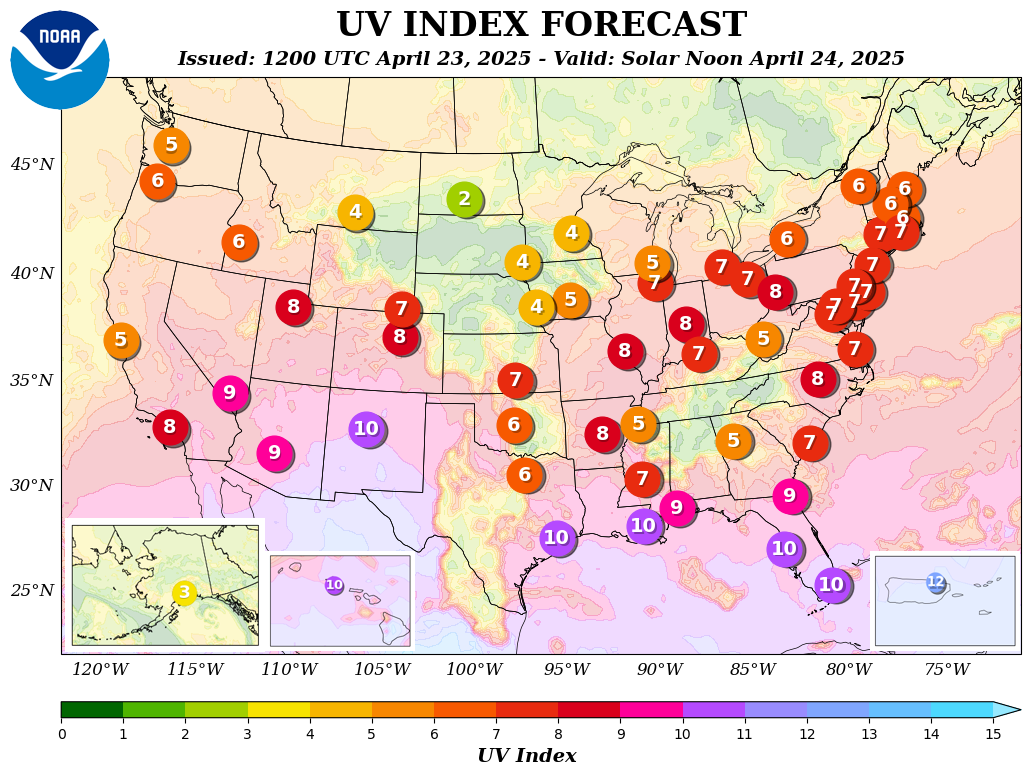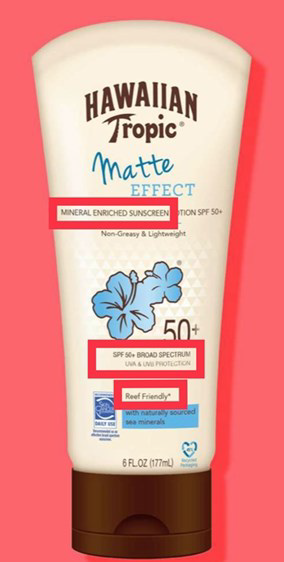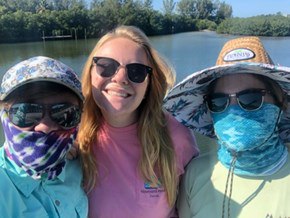This piece was written by Dr. Lindsey Warner and I stumbled upon the article while checking out the UF Lakewatch Program’s awesome newsletter! The sun safety info included was one of the most comprehensive and easy to read summaries I’ve read and Dr. Warner has graciously allowed me to adapt and repost the content here in IFAS blog format. Please spread the word on sun safety to anyone spending time outdoors especially during these next toasty summer months!
Living and working in Florida’s sunny subtropical climate poses challenges both to our health and our environment. As we learn more about sun exposure’s detrimental effects, sun protection is becoming ever more crucial. In this article, I will briefly walk you through the basics of UV exposure, sunscreens, their environmental impact, UPF clothing, and what it is they protect you against.
The Sun and UV Light

Let me start by taking us briefly back to what is sunlight. Sunlight actually consists of multiple wavelengths of electromagnetic energy that radiates from the sun, through our atmosphere and into our environment. The most damaging wavelength is called Ultraviolet (UV) light which is further divided into UVA and UVB. UVA waves penetrate the bottom-most layer of skin causing skin thinning, wrinkles, and tanning. UVB waves radiate the top layers of the skin, causing sunburn and most skin cancers.
Sun exposure in Florida can be especially damaging due to our proximity to the equator. The national weather service regularly tests the strength of UV radiation in most major US cities. This information is also included on most weather apps under “UV index.” What you will see is a number between 0 and 15 indicating the severity of radiation exposure in your area for that day. The higher the rating, the shorter the time in direct sunlight required to cause skin damage. Here in Florida, it only takes 15-25 minutes unprotected in the sun to cause cellular damage to your skin. This cellular damage triggers your pigment cells, melanocytes, to release more pigment, which is why people “tan” after sun exposure, but al-so increases the risk of cancerous mutations to the DNA of the skin.
UPF? SPF? What They Mean and Why They’re Important
The mainstays of sun protection, are wearing UPF clothing and sunscreen, seeking shade, and avoiding mid-day sun. Sunscreen acts by either deflecting or absorbing UV radiation before it can penetrate and damage our skin.

Sunscreens that have titanium or zinc oxide listed under active ingredients work by deflecting light and are known as “physical/mineral blockers.” These earth metals work very well as they can be compounded into creams giving us all the benefits of a suit of armor with none of the bulk. They are, however, more difficult to “rub in” and leave a white sheen on the skin. The other type of sunscreen, “chemical blockers/organic filters,” acts by absorbing the energy of the UV radiation into their chemical structure and releasing the energy as heat. They typically contain avobenzone, homosalate, octisalate, and octocrylene (usually all four together, in that order). Understandably these can be irritating to sensitive skin. On the other hand, they are easier to rub in, lighter weight, and less greasy. It is also important to note that not all ingredients block both UVA and UVB, in fact, of the ones discussed above only zinc, titanium, and avobenzone protect against UVA.
Now choosing the SPF is our next big step. SPF stands for sun protection factor and tells us what percent of UVB rays are blocked, which increases with increasing SPF though not in a one-to-one fashion. SPF 15 blocks 94% of UVB waves, and SPF 100 blocks 99%. So increasing SPF does marginally increase your UVB protection. Unfortunately, SPF tells you nothing about UVA protection. To make sure your sunscreen is also protecting you against damage from UVA radiation, look for a “broad spectrum” designation on the label, which is an FDA-regulated designation that assures UVA protection. In terms of the official recommendation, the American Academy of Dermatology recommends using 30 SPF or greater, broad spectrum, water resistant sunscreen. The sunscreen pictured is my personal favorite and I have highlighted the parts of the label I use to inform my choice (mineral/physical blocker, broad-spectrum, and reef-friendly).
Sunscreen and The Environment

What about sunscreen and the aquatic environment? This is certainly an important consideration when choosing a sunscreen, and especially pertinent in this field. It is estimated that 7 to 14 thou-sand tons of sunscreen enter our oceans per year and have been linked to the global decline and loss of coral reefs. In 2015 the US National Aquarium and US National Oceanic and Atmospheric Administration published a cornerstone study, led by Dr. Craig Downs, which found that oxybenzone (a com-mon chemical sunscreen ingredient) even in concentrations of 62 parts per trillion, caused coral cell toxicity. In response to this new information, Hawaii has recently successfully banned the sale of all sun-screens containing oxybenzone or octinoxate, on January 1, 2021. Though most research has been conducted in salt-water organisms, it is likely to be equally damaging to their fresh-water counterparts. Additionally, oxybenzone is very difficult to remove from wastewater, and even land-bound folks would do well to avoid increasing environmental exposure to these chemicals.
UV Blocking Clothing?
 This brings us nicely to the benefits of UPF clothing. UPF stands for ultraviolet protection factor and describes both UVA and UVB protection conferred by clothing. A UPF rating of 50 indicates that 1/50 of UV rays reach your skin, or conversely, 49/50 (98%) of rays are blocked. Fabric’s ability to block UV radiation is determined by the density of the weave or thread count and the types of dyes used. In fact, many darker articles of loose fitting, synthetic clothing offer good sun protection. As a rule of thumb, holding a fabric up to the light will give you a good idea of how much light will reach your skin. For example, a dark-colored polyester shirt has a UPF of 30+ (97% of UV rays blocked). A quick look into most of our wardrobes will show us that we have some sun-protective clothing al-ready. All-together, UPF clothing provides an environmentally safe, low hassle option that is my personal favorite and go-to. Though you may not get style points for a large, brimmed hat and full-coverage clothing, the ease and environmental benefits are unparalleled.
This brings us nicely to the benefits of UPF clothing. UPF stands for ultraviolet protection factor and describes both UVA and UVB protection conferred by clothing. A UPF rating of 50 indicates that 1/50 of UV rays reach your skin, or conversely, 49/50 (98%) of rays are blocked. Fabric’s ability to block UV radiation is determined by the density of the weave or thread count and the types of dyes used. In fact, many darker articles of loose fitting, synthetic clothing offer good sun protection. As a rule of thumb, holding a fabric up to the light will give you a good idea of how much light will reach your skin. For example, a dark-colored polyester shirt has a UPF of 30+ (97% of UV rays blocked). A quick look into most of our wardrobes will show us that we have some sun-protective clothing al-ready. All-together, UPF clothing provides an environmentally safe, low hassle option that is my personal favorite and go-to. Though you may not get style points for a large, brimmed hat and full-coverage clothing, the ease and environmental benefits are unparalleled.
Skin Cancer

Lastly, let’s discuss why we care about sun protection: skin cancer. Prolonged exposure to UV radiation causes alterations in the DNA of our skin cells.
In the US, skin cancer is the single most common cancer, and one in five people will develop it according to the American Academy of Dermatology. Risk factors include occupational exposure, tanning bed use, lighter complexion, and having immune problems. The three most common types of skin cancers are basal cell, squamous cell, and melanoma, and they are named after the types of skin cells affected. The deadliest, and most rare, is melanoma, a cancer of the pigment-producing melanocytes that can invade lymph nodes and spread if untreated. The American Cancer Society reports that in the US, it is responsible for 20 deaths a day and more than 100,000 cases of invasive melanoma were diagnosed last year. Fortunately, relative to other cancers, skin cancer has a very good survival rate of >92% if caught early and treated.
Because early detection is key, it is important to establish care with a dermatologist both for timely treatment and to learn more about prevention and identification of worrisome skin spots.
To summarize our key points, sunlight contains ultraviolet radiation that causes cellular damage/burn in a matter of 15-25 minutes here in Florida. UPF clothing or dark, loose-fitting fabrics are a convenient and environmentally safe way to protect your skin. For the exposed parts of your skin, look for reef-friendly, water resistant, broad-spectrum, 30+ SPF sunscreen. When it comes to sun exposure, skin protection equals cancer prevention. Skin cancer impacts one in 5 people in the US. Stay safe out there!”
Thank you Dr. Warner For letting me share this information! I look forward to checking out any additional articles from you in the future!
 1
1
